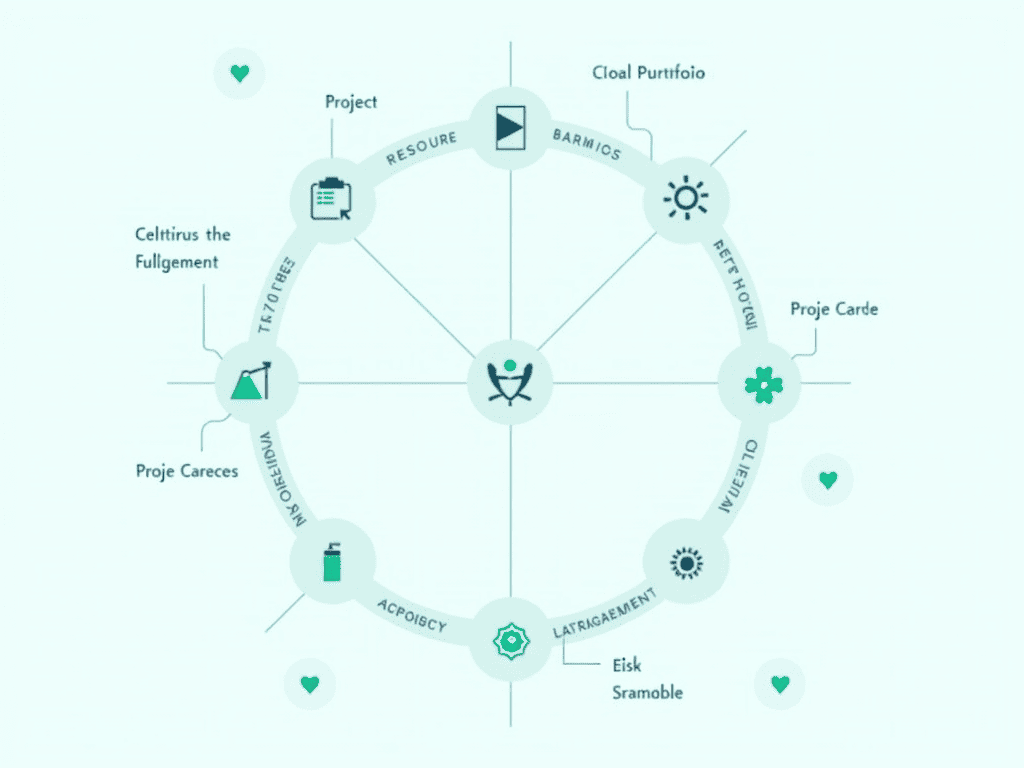
Understanding Project Portfolio Management (PPM)
Project portfolio management (PPM) functions as a central oversight system connecting strategic vision to project execution, ensuring all projects contribute meaningfully to organizational goals. Portfolio management in project management is essentially a systematic approach that helps organizations select, prioritize, and manage projects strategically while optimizing resources, managing risks, and delivering value.
Key Takeaways:
- PPM aligns project investments with strategic organizational objectives
- Effective portfolio management requires comprehensive evaluation of project contributions
- Resource optimization and strategic prioritization are critical components
- Risk management is integral to successful portfolio management
- Portfolio management improves decision-making through data-driven insights
PPM gives you the ability to view all projects collectively rather than individually, creating a clearer picture of how investments support company objectives. Portfolio management principles allow you to make better decisions about which projects to pursue, continue, or terminate.
The Strategic Importance of Portfolio Management
The strategic importance of portfolio management can’t be overstated. It provides a structured framework for evaluating potential projects against established criteria including financial returns, strategic alignment, and resource requirements.
Successful Implementation
Successful implementation requires both technical knowledge and organizational commitment. You’ll need appropriate tools to track performance metrics and regular reviews to adjust course as needed. Project portfolio frameworks offer guidance for creating sustainable processes that adapt to changing business priorities.
Maximizing Effectiveness
For maximum effectiveness, your portfolio management approach should integrate with existing governance structures while providing transparency to stakeholders. This creates accountability and helps build support for difficult decisions regarding project prioritization or termination.
Transforming Project Selection
Ultimately, good portfolio management transforms project selection from a subjective process to a data-driven one, ensuring your organization invests in initiatives that deliver the highest strategic value with available resources.
“Project portfolio management bridges the gap between strategic vision and execution, empowering organizations to prioritize and optimize projects for maximum impact. By aligning investments with organizational objectives and leveraging data-driven insights, PPM transforms decision-making into a strategic advantage.”
The Strategic Foundation
Project portfolio management (PPM) serves as a centralized oversight mechanism for all projects within an organization. At its core, PPM bridges the gap between strategic vision and project execution, ensuring what is portfolio management in project management delivers meaningful contributions toward organizational goals.
PPM provides the framework to select, prioritize, and manage projects that align with your business strategy. You’ll find that effective portfolio management requires balancing project prioritization, resource optimization, and risk management to maximize value delivery.
Understanding Project Portfolio Components
Before diving into portfolio management strategies, you need to understand the key components:
- Projects: Temporary endeavors with defined deliverables and timelines
- Programs: Groups of related projects managed in a coordinated way
- Portfolios: Collections of projects and programs aligned to strategic objectives
These components form a hierarchy where project and program differences become crucial to understand. Unlike individual project management, portfolio management takes a bird’s-eye view of all initiatives. Organizations implementing formal management practices experience a 92% project success rate compared to those without structured approaches.
Portfolio selection relies on strategic alignment assessment frameworks that evaluate how each project contributes to your organizational goals. You’ll need to apply value maximization techniques and risk assessment strategies when determining which projects to authorize. Proper project constraints and dependencies must be mapped to prevent resource conflicts.
| Aspect | Function | Benefit |
|---|---|---|
| Strategic Alignment | Ensures projects support business goals | Prevents wasted resources on non-strategic work |
| Resource Optimization | Allocates resources based on priorities | Maximizes return on investment |
| Risk Management | Balances project risks across the portfolio | Creates a diversified project mix |
| Performance Tracking | Monitors portfolio health metrics | Enables data-driven decision making |
Modern portfolio management leverages specialized software with real-time analytics and reporting features. These tools facilitate resource forecasting and risk tracking while integrating with collaboration platforms. According to industry research, 85% of project managers handle multiple simultaneous projects, making these technologies essential for maintaining oversight.
Effective portfolio management delivers significant benefits including improved decision-making through data-driven insights and enhanced resource utilization. You’ll gain increased organizational agility and transparent performance tracking by implementing a portfolio management process with proper governance structures.
When implementing portfolio management, start with establishing clear selection criteria and governance models. Address change management considerations early, as successful adoption requires cultural adaptation and comprehensive training programs.
Understanding Project Portfolio Components
Project portfolio management (PPM) serves as a centralized oversight mechanism for your organization’s projects. When asking what is portfolio management in project management, think of it as the bridge connecting strategy to execution. PPM ensures each project contributes meaningfully toward strategic goals through proper prioritization, resource optimization, and risk management.
Understanding what is portfolio management in project management requires clarity on three distinct components:
- Projects – Temporary endeavors with defined start and end dates designed to create unique products or services.
- Programs – Groups of related projects managed together to achieve benefits not possible when managed separately.
- Portfolios – Collections of projects and programs aligned with strategic business objectives.
These components form a hierarchy where individual projects may belong to programs, and programs reside within portfolios. This structured approach delivers impressive results—organizations implementing formal project and portfolio management practices achieve a 92% project success rate.
Distinguishing Portfolio Levels
Effective portfolio management requires clear categorization and mapping of interdependencies between components. Here’s how each level differs:
| Level | Focus | Timeframe | Key Question | Success Measure |
|---|---|---|---|---|
| Project | Delivering specific outputs | Short-term | “Are we doing things right?” | On-time, on-budget delivery |
| Program | Achieving defined outcomes | Medium-term | “Are we managing related projects effectively?” | Benefits realization |
| Portfolio | Maximizing strategic value | Long-term | “Are we doing the right things?” | Strategic goal achievement |
What is portfolio management in project management? It’s the disciplined approach to selecting, prioritizing, and overseeing your project investments. By mapping interdependencies between projects, you can identify critical paths and potential bottlenecks before they impact performance.
Proper portfolio component management helps you:
- Align project selections with strategic objectives
- Optimize resource allocation across multiple initiatives
- Maintain balanced risk exposure
- Maximize return on project investments
- Improve stakeholder satisfaction
What is portfolio management in project management if not the art of making the right project investments at the right time? By categorizing your portfolio components appropriately, you’ll gain visibility into how projects and programs contribute to your organization’s strategic goals.
Expert Insight: To excel in project portfolio management (PPM), develop a clear understanding of its three core components: projects, programs, and portfolios. This hierarchical approach ensures that each project aligns with strategic objectives, enabling effective prioritization and resource optimization. By recognizing interdependencies among these components, you can identify potential risks and maximize the overall return on your project investments, leading to improved success rates.
Portfolio Selection and Prioritization Methodology
Effective portfolio selection is the backbone of successful project management. You’ll need structured approaches to evaluate, select, and prioritize projects that align with your strategic objectives. What is portfolio management in project management? It’s the systematic process of selecting the right mix of projects to maximize value while balancing risks.
Strategic Alignment Assessment Framework
Before approving new projects, you must evaluate how well they support organizational goals. A robust strategic planning approach helps you establish clear criteria for project selection. Here are essential components of an effective portfolio selection methodology:
- Strategic Fit Evaluation: Assess how each project contributes to your strategic objectives
- Value Scoring: Quantify potential benefits using financial and non-financial metrics
- Risk Assessment: Analyze potential threats and opportunities
- Resource Requirement Analysis: Determine resource needs
- Interdependency Mapping: Identify relationships between projects
When selecting projects, you need a systematic approach to prioritization. This table summarizes key prioritization methods:
| Method | Description | Best Used For |
|---|---|---|
| Scoring Models | Numerically rate projects based on strategic criteria | Complex portfolios with diverse projects |
| Financial Analysis | Evaluate ROI, NPV, and payback periods | Revenue-generating initiatives |
| Bubble Charts | Visual representation of risk vs. reward | Executive-level portfolio reviews |
| Weighted Criteria | Assign importance values to different factors | Balancing multiple organizational priorities |
Your resource allocation must balance organizational capacity with strategic needs. Implementing capacity planning helps prevent bottlenecks and ensures efficient utilization of talent. What is portfolio management in project management if not the art of maximizing returns through careful resource distribution?
When evaluating potential projects, consider these value maximization techniques:
- Business Case Analysis: Evaluate the financial and strategic justification
- Benefits Mapping: Link project outcomes to organizational objectives
- Portfolio Balancing: Maintain diversity across project types and risk levels
- Resource Optimization: Allocate resources based on strategic importance
- Opportunity Cost Assessment: Consider the value of alternatives
Successful risk response strategies require diversification across your portfolio. You’ll need to balance high-risk, high-reward projects with safer initiatives to create a sustainable project mix. What is portfolio management in project management without proper risk management? Simply gambling with organizational resources.
Portfolio Management Tools and Technologies
Effective portfolio management in project management requires robust tools that provide comprehensive oversight and control. Your ability to select the right technology can significantly impact how you manage multiple projects simultaneously. What is portfolio management in project management? It’s a systematic approach that demands specialized software to succeed in today’s complex business environment.
Modern portfolio management software offers capabilities that transform how you track and optimize your project investments. These platforms provide real-time analytics and reporting features that help you make data-driven decisions about what is portfolio management in project management practice. With 85% of project managers handling multiple simultaneous projects, these tools have become essential rather than optional.
Essential Portfolio Management Technologies
The technology landscape for what is portfolio management in project management continues to evolve, offering increasingly sophisticated solutions. Here are the key technologies you should consider:
- Resource forecasting tools that predict capacity needs and prevent overallocation
- Risk tracking systems that identify potential issues before they impact project delivery
- Strategic alignment dashboards that visualize how projects support organizational goals
- Financial analysis modules that calculate ROI and track budget performance
- Integrated communication platforms that enhance stakeholder collaboration
When implementing program portfolio management tools, you’ll need to evaluate how they integrate with your existing systems. The right technology stack helps you maintain what is portfolio management in project management as a cohesive function rather than isolated activities.
The following table summarizes the core capabilities you should look for in portfolio management software:
| Feature | Purpose | Business Impact |
|---|---|---|
| Project prioritization | Rank initiatives based on strategic value | Ensures resources flow to highest-value work |
| Resource capacity planning | Match project demands with available resources | Prevents bottlenecks and overcommitment |
| Portfolio visualization | Graphically represent project relationships | Improves stakeholder understanding and buy-in |
| Risk management | Track and mitigate portfolio-level risks | Protects strategic investments |
| Financial tracking | Monitor budget performance across projects | Controls costs and maximizes returns |
Your project portfolio management process will benefit from technologies that provide comprehensive visibility across all initiatives. What is portfolio management in project management ultimately comes down to having the right information at the right time to make strategic decisions.
When selecting tools, prioritize those that enable efficient strategic planning and support your governance framework. The most effective solutions will help you balance resource constraints while maintaining focus on delivering what matters most to your organization.
Benefits and Organizational Impact
Effective portfolio management delivers powerful advantages for organizations that implement it properly. You’ll discover what portfolio management in project management brings several strategic benefits that extend beyond individual project success.
Portfolio management improves decision-making through data-driven insights. When you have a complete view of all projects, you can make informed choices based on performance metrics rather than assumptions. This visibility helps you satisfy stakeholders by demonstrating clear value from project investments.
Enhanced resource utilization is another significant benefit. Portfolio management helps you allocate people, budget, and equipment across projects based on strategic priorities. This prevents the common problem of resources being tied up in less valuable initiatives while critical projects struggle. What is portfolio management in project management fundamentally includes the optimization of your organization’s limited resources.
Your organization’s agility will increase through effective portfolio management. By regularly reviewing your project portfolio, you can quickly adjust to changing market conditions or strategic shifts. This flexibility allows you to:
- Cancel or pause underperforming projects before they drain resources
- Accelerate high-potential initiatives that align with emerging opportunities
- Reallocate resources where they’ll deliver maximum value
- Balance high-risk and conservative projects for optimal results
Transparent performance tracking becomes possible with portfolio management. You can monitor progress against strategic objectives and measure what portfolio management in project management contributing to organizational success. This transparency builds trust with executives and improves project implementation accountability.
ROI Improvements Through Portfolio Management
Portfolio management delivers measurable ROI improvements. The following table illustrates typical financial benefits organizations experience:
| Benefit Area | Typical Improvement |
|---|---|
| Project Success Rate | 25-40% increase |
| Resource Utilization | 15-30% improvement |
| Strategic Alignment | 35-50% better project-strategy fit |
| Time-to-Market | 20-35% reduction |
| Cost Savings | 10-20% across portfolio |
What is portfolio management in project management ultimately creates a framework for maximizing returns while minimizing waste. By implementing strong portfolio governance processes, you’ll establish a foundation for sustainable project success. The systematic evaluation of all initiatives ensures your organization invests in the right projects at the right time.
Implementing Portfolio Management: A Practical Guide
Portfolio management in project management centralizes oversight of all organizational projects, ensuring they align with your strategic objectives. When implementing a portfolio management approach, you’ll need a systematic plan that transforms how your organization evaluates, prioritizes, and executes projects.
Step-by-Step Implementation Strategy
To successfully implement what is portfolio management in project management, follow these key steps:
- Establish a governance structure – Create a portfolio management office with clear roles and decision-making authority. This structure will oversee project portfolio management processes and ensure accountability.
- Develop selection criteria – Define metrics that evaluate how projects align with strategic goals. Your criteria should assess potential ROI, risk levels, resource requirements, and strategic fit.
- Inventory existing projects – Catalog all current initiatives, their status, resource allocation, and expected outcomes to identify what is portfolio management in project management working for your organization.
- Prioritize your portfolio – Rank projects based on strategic importance, resource constraints, and organizational capacity. This helps eliminate non-essential projects and focus on high-value initiatives.
- Optimize resource allocation – Redistribute talent, budget, and materials across the portfolio based on prioritization. This prevents resource conflicts between projects.
- Implement portfolio management tools – Deploy software that provides visibility into all projects, supports decision-making, and enables project dependencies tracking.
- Create reporting systems – Establish standardized reporting methods that track portfolio performance against strategic objectives.
- Train your team – Develop competencies in what is portfolio management in project management practices across your organization, from executives to project managers.
Portfolio governance best practices include:
- Regular portfolio review meetings (quarterly at minimum)
- Documented decision-making processes
- Clear escalation pathways for issues
- Transparent communication about priorities
Organizations like Novo Nordisk have successfully implemented portfolio management by starting with small pilot programs before scaling. Their approach included defining clear success metrics and establishing specialized committees for portfolio oversight.
When implementing what is portfolio management in project management, you’ll need to address cultural resistance through:
- Executive sponsorship that champions the change
- Stakeholder education about portfolio benefits
- Recognition systems that reward strategic alignment
- Demonstration of early wins
The continuous improvement of your portfolio management system should involve regular assessment against industry benchmarks, gathering stakeholder feedback, and refining processes to adapt to changing business conditions.
Remember that 85% of project managers handle multiple simultaneous projects, making portfolio management essential for maintaining organizational focus and preventing resource conflicts that undermine strategic initiatives.






